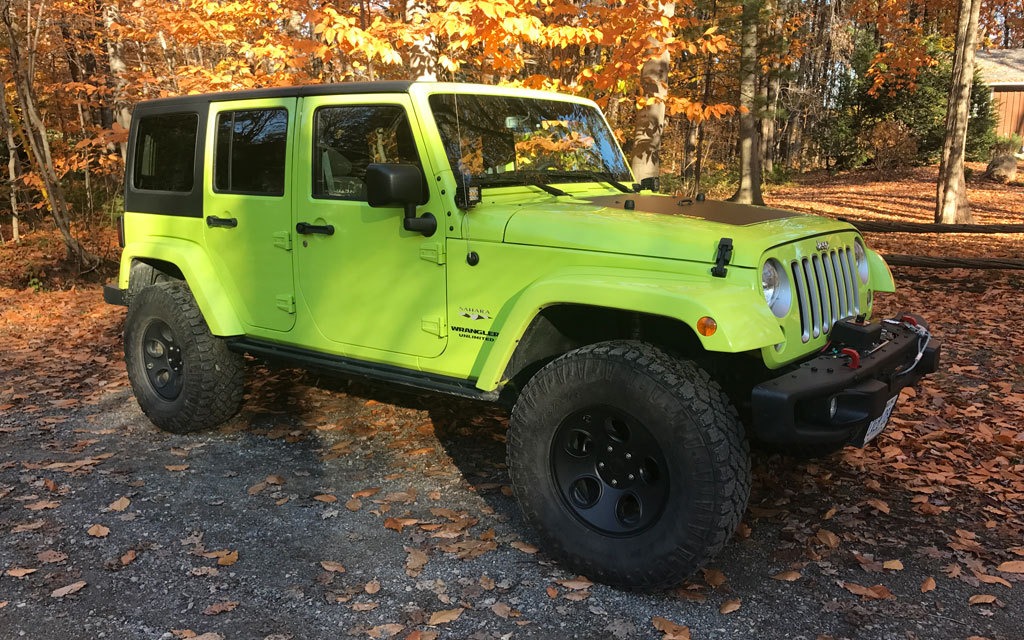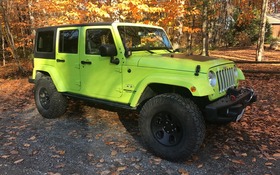2016 Jeep Wrangler Unlimited Sahara: With a Touch of MOPAR

| Strong points |
|
|---|---|
| Weak points |
|
Humans are a funny bunch sometimes. We’ve been known to make questionable acquisitions in our lives that often go against reason, but that give us pleasure. A good example might be an early twenty-something-year-old who forked out the equivalent of a down payment on a house in order to make sure he had the fastest Honda Civic around. These decisions aren’t a symptom of youth either. Grown adults have been well documented in making similar purchases during their midlife crises. The Jeep Wrangler fits into this category as something that many people desperately want to have, but may not make sense to a whole lot of other folks.
Nevertheless, the Jeep brand remains wildly popular and has worldwide name recognition so it must be worthwhile, right? As this was my first Wrangler test, I didn’t know what to expect, but I was excited to find out.
- Also: 2016 Jeep Wrangler Rubicon Hard Rock Edition: (Way) Off the Beaten Path
- Also: First Drive: 2016 Jeep Wrangler Unlimited Willys Wheeler
From the outside, the Jeep Wrangler cannot be mistaken for anything else. Its truly unique styling has been tweaked over the years, but is essentially the same overall boxy look that dates back to World War II. How many other brands have retained the same design for over the entire lifespan of their existence? The Porsche 911 comes to mind, but that’s about it. You know the old saying: “if it ain’t broke, don’t fix it.”
This particular model is the 2016 Jeep Wrangler Unlimited Sahara (MSRP $39,695) and has been fitted with a ton of MOPAR aftermarket goodies along with the brightest lime-green paint job you’ve ever seen. The color actually suits it quite well. The Sahara fits into the Jeep lineup just under the top-of-the-line Rubicon, so it’s already fairly well equipped, but the MOPAR mods really give it that extra touch. Let’s go through the list with the corresponding costs:
- 2” lift kit: $1,765
- 5-Hole classic wheels: $2,065
- Spare tire mount: $905
- Tailgate reinforcement: $270
- Skid plate: $693
- Rock Rails $1,015
- Windshield light mounting kit: $97.15
- LED flood lights: $687
- Front bumper: $1,150
- Rear Bumper: $1,370
- Warn Winch $1,235
Total: $11,252.15
That’s quite the package, but the best thing is that these are all very functional accessories that augment the Wrangler’s off-road capabilities—aside from maybe the wheels. I didn’t even find the wheels to be that attractive and there are plenty of aftermarket options that can be had for less.
With this setup, you can basically play Jurassic Park and run free over the countryside. Unfortunately I didn’t get the chance to do much off-roading and my usage was limited to mostly pavement going to and from daycare—the opposite of the Jeep’s intended use. Using the Jeep as a family hauler is probably why I wasn’t overly impressed with the vehicle’s overall practicality. It’s tough for small children to get in and out of, even without the lift kit.

The cargo area can be difficult to access as a result of the horizontally-swinging hatch that must be opened all the way to let the top glass open. This makes visits to tight grocery store parking lots a bit of a chore. Storing the soft top in the rear occupies a large amount of cargo space, but this can obviously be mitigated by its removal. In the end, I suppose it’s not the worst family hauler, but it wouldn’t be my first choice.
Driving the Wrangler takes some getting used to. Keep in mind this is an off-road vehicle and it wasn’t designed for your daily driving comfort. The ride is harsh, uncomfortable and noisy. There are shakes and rattles aplenty in the cabin. It’s not particularly fast nor does it handle like a go-kart. I expressed some of these views on social media and my Jeep owner friends simply replied with “It’s a Jeep thang.” Jeep owners are almost cult-like in their support of the brand and a little vibration isn’t going to sway their steadfast allegiance. To them, off-road capability is life and not much else matters. Jeep gets this fact, but has still engineered steady improvements in terms of comfort and ride quality than previous models.
Powering the Wrangler is a 3.6-litre V6 making 285 horsepower and 260 lb.-ft. of torque. That engine serves the Wrangler well and it can help it accelerate quite handily. It’s also enough power to haul you out of whatever mess you get into in the back country.

The interior of the Wrangler is a bit underwhelming in terms of modernity. I don’t’ see a ton of differences between this and the late-90s Chryslers I drove while working in the car rental industry. That said, if you plan to bring this vehicle off-road, modernity probably isn’t your main concern. You want something functional, rugged and tough enough to get the job done with ease, and this is what it accomplishes.
After a week in the flashy 2016 Jeep Wrangler Unlimited Sahara and getting numerous thumbs-ups, waves and stares from other Jeep owners, I started to actually feel like I was part of the Jeep crowd. In fact, I haven’t’ driven many other cars this year that generated this much attention. Even non Jeep people seemed to be drawn by its imposing presence. And you know something else? All the little things that bothered me about the drive started to slip from my memory and I enjoyed each opportunity to take the Wrangler out for a spin.
The Wrangler is one of the few remaining off-road ready vehicles you can buy right from the showroom and fills a niche market that is still in high demand. Its great looks and all-terrain prowess make it a very enticing option for the mud-loving explorer.











